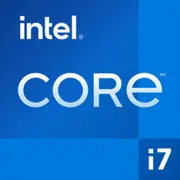Intel Core i7-7560U

Intel Core i7-7560U: Overview of the Processor for Ultrabooks in 2025
Analysis of Capabilities, Use Cases, and Relevance in the Era of Modern Chips
Architecture and Fabrication Process: The Dual-Core "Veteran" of Kaby Lake
The Intel Core i7-7560U processor, released in 2017, belongs to the seventh generation of Kaby Lake architecture. Despite its age, it can still be found in budget ultrabooks and business-class devices in 2025.
- Fabrication Process and Basic Structure: 14nm technology, 2 cores, 4 threads thanks to Hyper-Threading. Base clock speed is 2.4 GHz, with a maximum turbo mode of 3.8 GHz.
- Integrated Graphics: Iris Plus Graphics 640 with 64 MB of eDRAM. This was a significant advancement for its time—the chip handled 4K video and light gaming well.
- Architectural Features: Support for DDR4-2133, PCIe 3.0, optimization for energy efficiency. Kaby Lake improved VP9 and H.265 decoding, which is relevant for streaming.
Example: In 2025, even budget processors like the Intel Core i3-1315U (10 nm, 6 cores) outperform the i7-7560U in multi-threaded performance. However, for simple tasks, the difference is not always noticeable.
Power Consumption and TDP: Balancing Power and Battery Life
The TDP of 15W makes this processor ideal for slim laptops.
- Thermal Package: Even under maximum load, the chip does not require an elaborate cooling system.
- Energy-Saving Technologies: Intel Speed Shift for rapid switching between P-states, Dynamic Tuning for adapting to workload.
Tip: In modern ultrabooks (2025), TDP is often reduced to 9-12W to increase battery life, but the i7-7560U does not support such "out of the box" modes.
Performance: What Can a Dual-Core Processor Achieve in 2025?
Geekbench 6 (1135 / 2175) — modest scores, but sufficient for a range of tasks.
- Office Work: Word, Excel, browser with 10+ tabs—the processor manages well, but stuttering might occur when running Zoom and Photoshop simultaneously.
- Multimedia: 4K video playback in VLC or YouTube works without issues, but rendering in DaVinci Resolve will take 3-4 times longer than on a Core i5-1240P.
- Gaming: Iris Plus 640 can run CS2 on low settings (720p, 30-40 FPS), but games like Cyberpunk 2077 are inaccessible even on minimum settings.
- Turbo Boost: The boost to 3.8 GHz lasts 20-30 seconds before the frequency drops to 2.8-3.0 GHz due to TDP limitations.
Example: A Dell XPS 13 7560 (2017) with this processor can today be purchased for $300–400 during sales. For a student writing papers and watching lectures, this is sufficient.
Use Cases: Who Is the i7-7560U Suitable For in 2025?
- Everyday Tasks: Web surfing, online courses, document work.
- Office Workers: Connecting to corporate clouds, using 1C.
- Seniors and Students: Simplicity, reliability, lack of excessive power.
Not Suitable For:
- Video editors, gamers, engineers (CAD, modeling).
- Fans of Windows 12 with AI features—this processor lacks an NPU.
Battery Life: How Long Will the Battery Last?
- Operating Time: On devices with a 50 Wh battery—up to 6-7 hours under moderate load (50% brightness, Wi-Fi).
- Energy Savings: Windows "Power Saving" mode, disabling Turbo Boost via utilities like ThrottleStop.
Tip: It's better to choose laptops with this CPU that have FHD screens rather than 4K—resolution impacts battery life more than the processor itself.
Comparison with Competitors: How Does It Stack Up Against AMD, Apple, and Newer Intel?
- AMD Ryzen 3 5300U (2021): 4 cores, 8 threads, Geekbench 6 ~1400/4000. With the same TDP, multi-threaded performance is twice as high.
- Apple M1 (2020): Single-thread score ~2300, multi-thread score ~8000. Lower power consumption, battery life of MacBook Air—up to 18 hours.
- Intel Core i3-1215U (2022): 6 cores (2P + 4E), 8 threads, Geekbench 6 ~1800/5500.
Conclusion: In 2025, the i7-7560U is only relevant as a budget solution. New laptops with processors like the Core i3-1315U start at $600, while devices with the 7560U can be found for $350–450.
Pros and Cons
Strengths:
- Low thermal output—suitable for passive cooling.
- Support for Thunderbolt 3 (often lacking in modern budget models).
- Sufficient performance for basic tasks.
Weaknesses:
- Only 2 cores—multi-tasking capabilities are limited.
- Outdated 14nm architecture (in 2025, mainstream processors are 5-7nm).
- No support for PCIe 4.0, Wi-Fi 6E, DDR5.
Recommendations for Choosing a Laptop
- Type of Device: Ultrabooks (e.g., Lenovo ThinkPad X270), budget hybrid 2-in-1s.
- What to Look for:
- RAM—at least 8GB, preferably 16GB for Windows 11/12.
- SSD of 256-512GB (SATA or NVMe).
- IPS display with FHD—avoid TN screens.
- Avoid: Laptops with HDD, 4K displays (this CPU is overpowered for that), gaming models.
Example: An HP EliteBook 840 G4 with an i7-7560U, 16GB RAM, and 512GB SSD costs around $400 in 2025—this is a good option for remote work.
Final Conclusion: Who Is This Processor Suitable For?
The Intel Core i7-7560U in 2025 is a choice for those who:
1. Are looking for a very cheap new laptop (up to $450).
2. Do not plan to run "heavy" applications.
3. Value portability and quiet operation (without noisy fans).
Key Benefits: Low price, proven reliability, compatibility with Windows 10/11. However, for future upgrades or working with AI tools, such a laptop will not suffice. If the budget allows, it’s better to pay more for a device with an Alder Lake or Ryzen 7000 processor—they will last longer.
Basic
CPU Specifications
Memory Specifications
GPU Specifications
Miscellaneous
Benchmarks
Compared to Other CPU
Share in social media
Or Link To Us
<a href="https://cputronic.com/index.php/cpu/intel-core-i7-7560u" target="_blank">Intel Core i7-7560U</a>